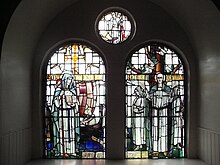Saint Molua, (c.530 – 592), (also known as Lua, Luan, Luanus, Lugaidh, Moloag, Molluog, Moluag, Murlach), was an Ulster missionary, and a contemporary of Comgall, Columbanus and Columba, who evangelized the Caledonian Cruthin or Picts in the sixth century. Saint Molua was the patron saint of Argyll as evidenced by a charter in 1544, from the Earl of Argyll, which states “in honour of God Omnipotent, the blessed Virgin, and Saint Moloc, our patron“.
Molua, born in Ireland, was a noble of the Dàl nAraide (Dalaradia) or Ulster Cruthin and was educated in Bangor under Comgall. Tradition states that the rock, on which Molua, or Moluag as he was known in the Hebrides, was standing, detached itself from the Irish coast and he drifted across to the island of Lismore, in Loch Linnhe. According to the Irish Annals, in 562 Molua beat Saint Columba in a race to the large island of the Lyn of Lorn in Argyll, now called the Isle of Lismore. WS Skene claims it was the sacred island of the Western Picts and the burial place of their kings whose capital was at Beregonium, across the water at Benderloch.
Molua was accompanied to north Britain by his kinsman Comgall , who presented him to King Brude of the Northern Picts to obtain permission to carry on his mission of spreading Christianity. It is likely that King Brude preferred Molua to Columba because of Columba’s close relation to the Gaelic-speaking leadership of Dàl Riata and the “Ui Neill”. This explains why Molua evangelized largely Pictish areas and Columba stayed within the sphere of Dál Riata or Scottish (Irish) influence.
After founding an island monastery on the Isle of Lismore, Molua went on to found two other great centres in the land of the Picts at Rosmarkie and Mortlach. These were his three centres of teaching, and it is significant that all three were to become the seats of the Roman Catholic Sees of the Isles, Ross and Aberdeen. So it was that St Bernard of Clairvaux wrote of Bangor in his biography of Malachy in the twelfth century :“A place it was, truly sacred, the nursery of saints who brought forth fruit most abundantly to the Glory of God, insomuch that one of the sons of that holy congregation, Molua by name, is alone reputed to have been the founder of a hundred monasteries”. Molua died in Rosemarkie, Scotland on June 25, 592. The Annals of Ulster record the death of Lugaid of Les Mór in 592 “Obitus Lugide Lis Moer.”
Molua is said to have been buried at Rosemarkie on the Moray Firth, though his remains were later transported to Lismore, and honoured in the cathedral which bore his name. The Coarb, or successor, of Saint Molua, is the Livingstone chief of the Clan Mac Lea. This Livingstone family of Lismore had long been the hereditary keepers of the crozier of the saint. The bell of Saint Molua was in existence until the sixteenth century when it disappeared during the Reformation. An ancient bell found at Kilmichael Glassary, Argyll is thought to have been the lost bell. St Molua’s parish church at Stormont, Belfast commemorates his name, although he has been totally confused over the centuries with St Molua of Killaloe.
To be continued
© Pretani Associates 2014
